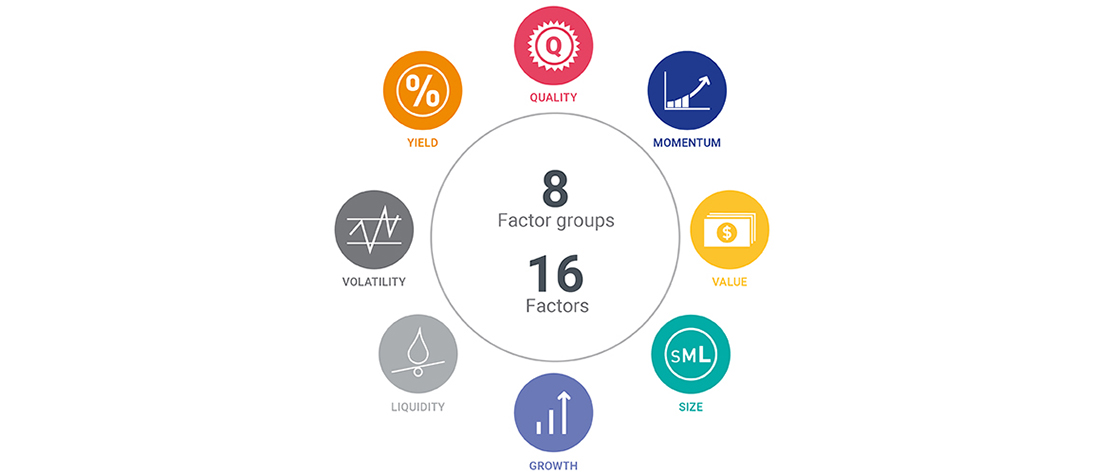MSCI FaCS landing page hero image
FaCS
A common language for implementing factor investing strategies
Are factors too complicated?
Introducing our latest Factor Innovation – MSCI FaCS
MSCI Factor Classification Standards

Based on MSCI’s Global Equity Factor Model, MSCI FaCSTM includes eight factor groups, and 16 factors.
Factor investing is transforming the way investors construct and manage portfolios. The increasing popularity of factor investing can create the need for standards.
MSCI has been at the forefront of driving factor innovation for over 40 years, beginning with Barra, which established a common language to explain risk and return through the lens of factors.
MSCI FaCSTM and MSCI Factor Box are designed to provide the structure and standardization for evaluating, implementing and reporting factor exposures.
Contact Us Button (Contact Sales)
MSCI FaCS
MSCI FaCS TM
It is well established that factors have historically been key drivers of risk and return in equity portfolios. Our research (Roisenberg, 2017) suggests that industry, country, currency and style factors account for approximately 55% of the active return of a sample of approximately 882 actively managed global mutual funds from September 2003 to December 2016. Within the factor contribution, style factors made up the largest portion of active returns — 35%.
MSCI FaCSTM creates a common language and set of definitions around factors to be used by a broader audience including asset owners, managers, advisors, consultants and investors. Investment managers can use the framework to analyze and report factor characteristics, while investors and consultants can use the data to compare funds using common factor standard definitions.

MSCI FaCS on Funds
Investors who use factors to help construct and manage portfolios need a common standard in order to analyze funds and conduct due diligence. MSCI FaCS on Funds provides further insight into factor exposures and allows investors to use a common language for evaluating and comparing ETFs and mutual funds through MSCI FaCS’s eight factor groups.
Download the factsheet
(PDF, 254 KB) (opens in a new tab)
MSCI Factor Box
The Factor Box, powered by MSCI FaCSTM, creates a common language for factor investing. The Factor Box provides a visualization designed to easily compare factor exposures between funds and benchmarks. It includes factors that have historically demonstrated excess market returns over the long run.
The MSCI Factor Box aims to help investors identify factor exposures compared to their intended benchmark. This may help investors make better-informed decisions on fund selection, fund monitoring and holistic portfolio analysis based on their fund exposures and investment objectives.
The FaCS report - ESG
The FaCS report
The FaCS report allows investors to understand what's driving their investments and helps them build better portfolios.
In the report you’ll be able to:
- Compare point in time key exposures of 8,000+ stocks, 11,000+ mutual funds and 1,500+ ETFs
- Compare historical key exposures (10+ years) of 8,000+ stocks, 11,000+ mutual funds and 1,500+ ETFs
- Compare 11 GICS sector factor exposures to understand the evolution of sectors and style factors
MSCI FaCS Duplicate 1
| Factor group | What it offers |
|---|---|
| Value
Relatively inexpensive stocks |
Captures excess returns to stocks that have low prices relative to their fundamental value |
|
Low size (small cap) |
Captures excess returns of smaller firms (by market capitalization) relative to their larger counterparts |
| Momentum Rising stocks |
Reflects excess returns to stocks with stronger past performance |
| Low volatility Lower risk stocks |
Captures excess returns to stocks with lower than average volatility, beta, and/or idiosyncratic risk |
| Dividend yield Cash flow paid out |
Captures excess returns to stocks that have higher-than-average dividend yields |
| Quality Sound balance sheet stocks |
Captures excess returns to stocks that are characterized by low debt, stable earnings growth, and other “quality” metrics |
| Growth Measure of change in sales and earnings |
Measures company growth prospects using historical earnings, sales and predicted earnings |
| Liquidity Size-adjusted trading volume |
Captures common variations in stock trading volumes relative to available shares trading |
Further reading
Creating a Common Language for Factor Investing - read the blog
Introducing MSCI FaCSTM - read the research paper


